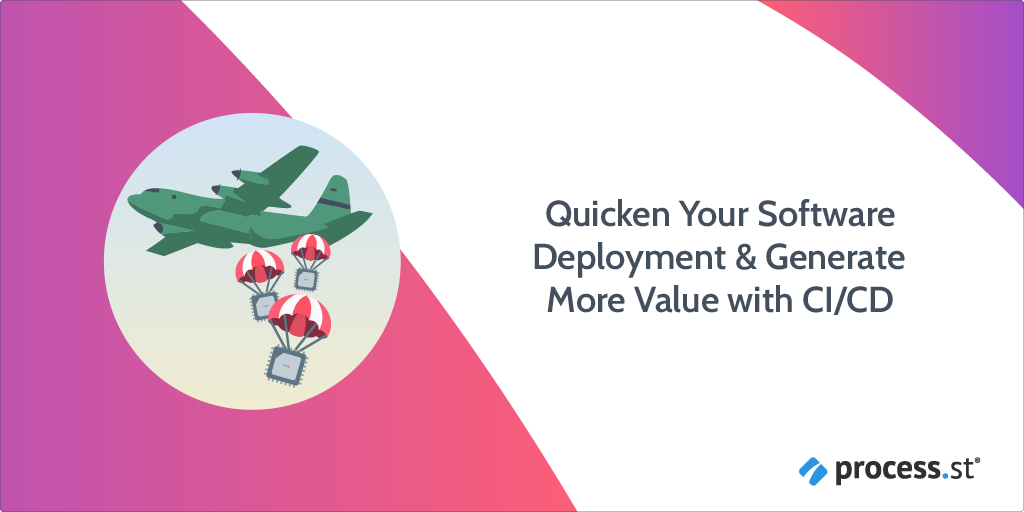
This is a guest post by Gabe Nelson. Gabe is a content specialist with over 7 years of experience, currently working with Semaphoreci.com. He has a passion for programming and has written hundreds of content pieces in numerous niches. Currently, he lives in Missouri with his wife and kids.
Let’s face it: the longer your software takes to get from ideation to iteration, the more irrelevant it becomes.
With the innovation of new paradigms and working methods to meet the right here/right now demands of consumers in a hyper-connected world, your developers need workflows that will deliver your software into production environments the second they’re able to.
The millisecond micro nanosecond, even.
Managing your software deployment processes and procedures to not just keep up with, but stay ahead of, the competition can seem like a Sisyphean task, but it doesn’t have to be.
Continuous integration (CI) and continuous delivery (CD) together constitute the light at the end of a software developer’s tunnel. No doubt that’s why implementation is commonly described in terms of “pipelines” – CI/CD takes you straight through the problems.
More specifically, CI/CD pipelines make it easy for developers to deploy working code into functional and error-free production environments. That’s because these workflows do a great job of automating entire pipelines of your team’s code releases and updates. This frees up developers to create new features and processes instead of spending hours debugging faulty code.
In this Process Street guest post, I’ll do a quick walkthrough of the basics of CI/CD, then dive into how CI/CD can generate more value for and quicken your software deployment.
- What is CI/CD?
- Commit to the build
- Automate testing throughout deployment cycle
- Initiate software deployment
- Documenting your deployment life cycle
- The value of CI/CD pipelines in software deployment
What is CI/CD?
Though it may seem elusive, CI/CD has become the new standard for successful software development. The two-part framework systematically modernizes an increasingly demanding world faced by software development teams.
But how did you get here? What was so taxing about the state of widespread coding solutions that made systematic innovation so necessary? And do these pipelines work as well in practice as they sound in theory?
As the landscape of software continues to shift, methodologies have emerged under a new school of thought: agile software development. This “agile” development refers to a spectrum of methodologies established by fourteen leading figures in software development via the Agile Manifesto.
The word “agile” was chosen to represent the concept of seamless adaptation to a rapidly changing environment. While agile software development does function as a framework for developing software, the primary focus on the Manifesto and attached principles is on self-organizing and cross-functional collaboration.
The practical CI/CD pipeline emerged in accordance with these beliefs, to create faster release cycles and increased quality in software. Namely, user feedback, market shifts, and any changes to requirements are more readily met with more adaptable software.
Thus, CI/CD is as philosophical as it is logical, combining the element of collaboration with a set of best practices. This synergy established between the two self-organizing, cross-functional camps opens new possibilities as requirements and solutions evolve in real-time.

Software deployment procedures are the snowflakes of the digital world: each one is uniquely complex and easily fractured. That said, deployment does tend to follow general frameworks that are at least recognizable among developers, if not exactly identical.
The same is true for establishing an effective CI/CD pipeline for your deployment process. Each approach will vary by development team, but most can agree that there are three main stages to the formula. These stages are:
- Commit to the build
- Testing
- Deployment
Commit to the build
Whenever you finish making changes to your application, simply commit your code to a shared repository – more on that later. Committing the code essentially allows you to integrate your work with the central codebase.
The new software or feature can then be built from isolated code and then rigorously tested. CI streamlines this process by automating each step after code is written.
Use CI/CD to catch errors early
You may be wondering just what, exactly, it is that CI/CD pipelines do to help squash bugs before they can get into a production environment. The answer is simple: feedback.
Software developers need constant loops of feedback to catch errors in their code early and often, reliably. CI/CD pipelines achieve this through a continuous loop of feedback from one developer to another that catches as many errors as possible before they can make their way into production.
It’s important to establish a constant feedback loop to quicken your releases into production and avoid errors in your code. Because the slower the feedback loops, the longer adjustments and releases take. You can strengthen your loop of feedback by automating as many tasks as possible that are part of your CI/CD pipeline.
Traditionally, each developer works on their part of the app, combining it with the rest of the team’s work later. It can take days or weeks to see if the new code works, depending on the development cycle schedule.
Think of it this way, the fewer tasks you need to manually address, the more time you can spend incorporating your colleagues’ feedback into your code. Coordinate with your team as well as other teams you regularly interact with to decide which tasks to automate first, and which ones you can save for later.
Because once a project incorporates continuous integration, it can be continuously delivered: software updates take less time and work. Releases become less of an event and more commonplace, ready to be performed on-demand when the new code is ready. And if bugs are found, they can be easily squashed: just release the next update.

Remember your repositories
Stellar code isn’t written in a silo, especially not when you’re working with a CI/CD pipeline. It’s important to collaborate with your colleagues using available repositories so that you avoid tunnel-visioning and subsequently producing buggy code. In other words, never produce code in a CI/CD pipeline without taking advantage of version control.
Version control is the single best way to continue to make productive changes to your code while your colleagues can feel free to do the same to theirs. Your repository will help you set up which personnel can access, change, and deploy their code, all while making sure you don’t lose any progress on your work.
This allows you to continue working and, if you happen to identify an issue in your code that doesn’t play nice with other code, you can resolve it without hindering anyone else’s progress.
You can merge code changes in a shared repository several times daily so projects can be continuously improved. This then allows for continuous development, the ability to get new builds to users as quickly as possible.
Keep in mind that, while CI significantly reduces errors during the development cycle, CD ensures each update is smaller. Condensed updates can be delivered more frequently: new features get into production faster, so consumers can receive the product asap.
Automate testing throughout deployment cycle
Once the new software is developed and then built, test to meet all requirements. There are multiple methods to enact relevant tests of function and performance. Various products allow you to create and run automated tests conveniently, enabling seamless workflow.
During the automated testing period, make sure you test the entire system in environments like the production environment. After all, the software is only good if it works for users – nevermind all the tedious work involved!
Manual vs. automated testing
Manual testing is still very much alive in the industry in every stage of the development cycle. It serves its purpose, as in the case of exploratory testing, but it can hold up the iterative delivery process.
Automation is the better method because it accelerates the building and deployment stages through continuous testing and feedback. Without the continuous commitment of code, you will face longer periods between integrations, which is fatal for projects. Namely, it becomes harder to find and fix bugs, easily derailing progress far before the testing stage.
Each testing stage can be divided by objective – but whether testing for functionality, security, or performance, it should be automated. Your test ‘suites’ ensure your software meets overall business requirements.
For example, regression testing re-evaluates scenarios whenever you make a change to ensure the application’s primary purpose hasn’t been broken. Parallel testing, meanwhile, is when you run multiple tests at the same time on different systems or browsers.
Improving test environments is therefore critical, and CI/CD plays an integral role in streamlining that process. An automated environment allows for testing easily, with just a few clicks, to keep up with the tides of technology.
Make the most of test-driven development

Test-driven development – or TDD – is crucial to any software development team’s rate of producing error-free code. TDD is a common component of both the staging and testing phase of your development and for good reason. Without TDD, you and your team would have no clue as to which code you’ve been working on can safely be pushed into production, and which code you still need to refine.
This will save countless hours that you would otherwise spend on manual testing. To quicken your software development releases, you need to know how much risk you are realistically introducing into production. TDD makes this easy by emphasizing quality code during the testing phase, not after.
Your team will spend considerably fewer hours sorting out bugs in countless iterations of your code if you simply rely on TDD to help sort them out for you. Plus, spending more time during development on honing the cycles and tools you use to test your code will free up valuable time later on to increase the rate at which you develop usable code for production.
Initiate software deployment
Once the software piece is built and tested, it can be rolled out into production. This is where CD comes in, automating the procedure to ensure delivery to users.
During the deployment stage, you can track any changes, merge your team’s modifications, and restore previous project versions as necessary. This then allows you to schedule and frequently deploy builds for continuous delivery, quickening release.

Lower costs and improve quality
Establishing a model of continuous development will lower the overall costs associated with building and testing application changes. That’s because automated testing environments reduce test infrastructure costs.
Parallel testing, for example, reduces the sheer number of machines required for testing. Automated testing means less time spent; and since time is money, that’s a lot of money saved.
And you don’t have to worry about sacrificing quality for quantity, either. At every level, these pipelines improve efficiency and effectiveness for developers, establishing a host of new advantages for application businesses.
Don’t skimp on security
It should go without saying that secure code is quality code. Your CI/CD pipeline is the repository for your team’s most important digital assets, lines of code, formalized processes, and much more. It’s easy to guess, then, how insecure code can quickly compromise the integrity of your pipeline if you don’t have any security measures in place.
Fortunately, it’s not difficult to marry your security procedures with the code you develop. You can start by determining which personnel on your team (or simply which personnel within your organization) should have permissions to access your pipeline as well as what data they can access.
Larger enterprises can take advantage of more than one working, physical network to safeguard the entry points that your code uses to access your environments. Make sure that you coordinate with the personnel in your organization who manage your security infrastructure. That way you can stop spending time worrying about “backdoors” into your pipeline that can potentially compromise your work.
Keep yourself on the cloud

Cloud environments are particularly handy for CI/CD pipelines since they can juggle so many moving parts of your development operations. For instance, if you want to stage some automation tests but also want to be able to push code into production on the same platform, then cloud server environments have you covered.
You can reliably quicken your releases by consolidating the different elements of your development into one, cloud-native environment. Typically, physical networks are resource-intensive and time-consuming when it comes to using them to conduct tests. Say, for example, you need to finish the unit and system testing that your team requires for your code by a certain deadline.
But, you can only rely on a physical network’s resources to get your testing done. The time it takes to complete these tests will eat into otherwise productive software development time. Instead, do you and your team a favor and host your CI/CD pipeline on a cloud server.
Documenting your deployment life cycle
The deployment cycle can easily be repetitive; it usually involves completing the same tasks in the same order, over and over again. That said, these tasks aren’t easy or simple, so the chance of error is high.
To guard against this, you need to be sure you have your processes thoroughly documented and updated on a regular basis. The easiest way to do this is by utilizing business process management (BPM) software. BPM software can be used for all of your company’s processes, but specifically in terms of the software deployment process, BPM software can also encourage and increase communication between team members.
A tool like Process Street’s superpowered checklists, for example, use notifications to alert different team members when their task is ready to be completed. So if the developers and designers have completed their work, the QA tester will be notified that they need to check the new features function correctly. Adding an app like Zapier will also simplify your automation. You can trigger Zaps to automatically update your communication channels when different stages are reached – or even when a new patch or update is being released so everyone from the development team to the marketing team to customer success receives the most current information at once with minimal effort.
These are just a few examples of how you can manage your deployment processes. Whether you use Process Street, G Suite, or some other tool, maintaining a digital knowledge base of all your processes and procedures will ensure software deployment runs smoothly, and the teams involved in building your pipelines communicate effectively.
The value of CI/CD pipelines in software deployment

CI/CD pipelines are a powerful framework for speeding up your software deployment cycle. Not only will your product reach consumers faster, but it will be of higher quality as well. CI/CD pipelines increase efficiency, catch errors early, formalize testing processes, and maintain seamless version control.
How does your team use CI/CD pipelines? Tell us your tips and tricks for creating stellar systems!







 Workflows
Workflows Forms
Forms Data Sets
Data Sets Pages
Pages Process AI
Process AI Automations
Automations Analytics
Analytics Apps
Apps Integrations
Integrations
 Property management
Property management
 Customer management
Customer management
 Human resources
Human resources
 Information technology
Information technology



Leks Drakos
Leks Drakos, Ph.D. is a rogue academic with a PhD from the University of Kent (Paris and Canterbury). Research interests include HR, DEIA, contemporary culture, post-apocalyptica, and monster studies. Twitter: @leksikality [he/him]